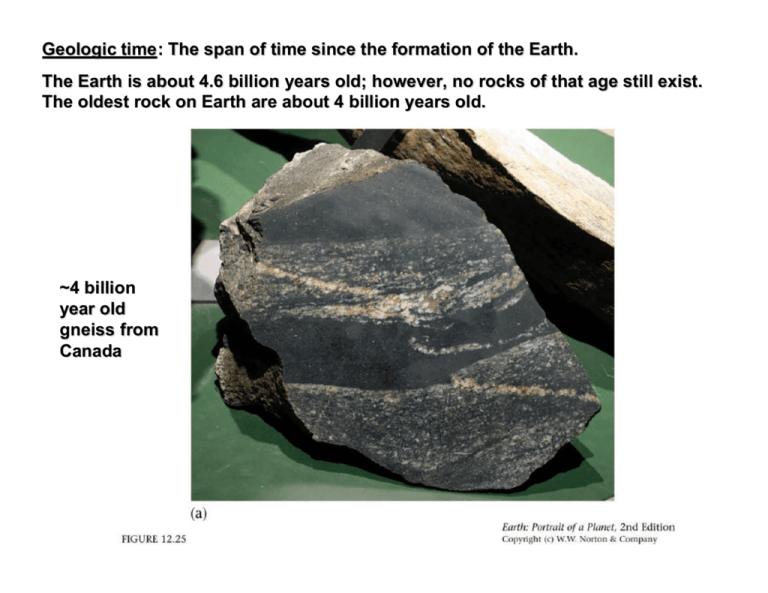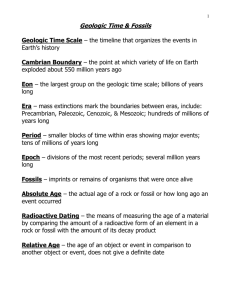Historical geology
advertisement

Geologic time : The span of time since the formation of the Earth. The Earth is about 4.6 billion years old; however, no rocks of that age still exist. The oldest rock on Earth are about 4 billion years old. ~4 billion year old gneiss from Canada Within a sedimentary rock located in Jack Hills, Western Australia, the worlds oldest detrital mineral grain was found. It is a mineral called zircon that was dated at ~4.4 billion years old (pictured below using Cathodoluminescence to give the mineral a false color) http://www.geology.wisc.edu/zircon/Earliest%20Piece/Earliest.html http://www.geology.wisc.edu/zircon/Earliest%20Piece/Earliest.html Moon rocks have yielded ages as old a 4.57 billion years old, and it is thought that the moon formed from the Earth, so the Earth must be older than 4.57 billions years old. Geologist like to use two terms to describe time: Relative age: The age of one geologic feature with respect to another. Numerical age: The absolute or numerical age of a geologic feature. There are several PHYSICAL PRINCIPALS for defining relative age: The principal of uniformitarianism: The physical processes we observe today also operated in the past in the same way, and at comparable rates. Mud cracks that are forming today Mud cracks that formed 100’s of millions of years ago. 12_04c.jpg Principle of superposition : In a sequence of sedimentary rock layers, each layer must be younger than the one below, for a layer of sediment cannot accumulate unless there is already a substrate on which it can collect. 12_04e.jpg principle of original horizontality: Layers of sediment, when originally deposited, are fairly horizontal. principle of original continuity: Sedimentary layers, before erosion, formed fairly continuous sheets over a region. 12_04fg.jpg 12_11a.jpg The Grand Canyon is an example of superposition, original horizontality and original continuity. principle of cross-cutting relationships: If one geologic feature cuts across another, the feature that has been cut is older. 12_04h.jpg 12_04ij.jpg principle of inclusions : If a rock contains fragments of another rock, the fragments must be older than the rock containing them. 12_04ij.jpg principle of baked contacts : When an igneous intrusion “bakes” (metamorphoses) surrounding rock, the rock that has been baked must be older than the intrusion. 12_05a.jpg 12_05b.jpg 12_05a.jpg Geologic History A cross-section through the earth reveals the variety of geologic features. View 1 of this animation identifies a variety of geologic features; View 2 animates the sequence of events that produced these features, and demonstrates how geologists apply established principles to deduce geologic history. 8PC version principle of fossil succession : In a stratigraphic sequence, different species of fossil organisms appear in a definite order; once a fossil species disappears in a sequence of strata, it never reappears higher in the sequence. 12_07.jpg D_04.jpg fossil: The remnant, or trace, of an ancient living organism that has been preserved in rock or sediment. fossil assemblage : A group of fossil species found in a specific sequence of sedimentary rock. Range: The interval of a sequence of strata in which a specific fossil species appears. 12_13.jpg fossil correlation: A determination of the stratigraphic relation between two sedimentary rock units, reached by studying fossils. fossil correlation: A determination of the stratigraphic relation between two sedimentary rock units, reached by studying fossils. Cherts in Washington State correlate to cherts in Oregon due to the same fossils in both rocks. Cherts in Oregon State correlate to cherts in Washington due to the same fossils in both rocks. 12_12.jpg Lithologic correlation: A correlation based on similarities in rock type. 12_17b.jpg Lithologic correlation 12_17a.jpg Lithologic correlation 12_09ab.jpg Commonly there are gaps in geologic Commonly there are gaps in geologic time because rocks of a certain age could be missing. We call these... unconformities: A boundary between two different rock sequences representing an interval of time during which new strata were not deposited and/or were eroded. There are 3 types of unconformities: 1) Angular unconformity: An unconformity in which the strata below were tilted or folded before the unconformity developed; strata below the unconformity therefore have a different tilt than strata above. 12_09ab.jpg Nonconformity : A type of unconformity at which sedimentary rocks overlie basement (older intrusive igneous rocks and/or metamorphic rocks). 12_09c.jpg disconformity : An unconformity parallel to the two sedimentary sequences it separates. Types of Unconformity This animation shows the stages in the development of three main types of unconformity in cross-section, and explains how an incomplete succession of strata provides a record of Earth history. View 1 shows a disconformity, View 2 shows a nonconformity and View 3 shows an angular unconformity. 8PC version 12_08a.jpg Angular unconformity 12_08b.jpg 12_10.jpg Disconformities and nonconformities are common in the grand canyon The succession of rocks in the Grand Canyon can be divided into formations based on notable changes in rock type and changes in fossil assemblages 8PC version 12_11b.jpg 12_15.jpg geologic column : A composite stratigraphic chart that represents the entirety of the Earth’s history. Eon: The largest subdivision of geologic time. Era : An interval of geologic time representing the largest subdivision of the Phanerozoic Eon. Period: An interval of geologic time representing a subdivision of a geologic era. Epoch: An interval of geologic time representing the largest subdivision of a period. 12_16a.jpg hadean archean proterzoic carbonifperm- erous ian devonian silurain triassic jurassic cretaceous holocene Cambrian ordovician paleoeocene cene pliocene pleistocene mioceneoligocene Life evolution in the context of the geologic column. before the Cambrian, there was little life on Earth, then there was an explosion of life starting at the Cambrian. 12_16b.jpg D_12.jpg A number of mass extinctions has also occurred during geologic time. These extinctions helped define the periods. 12_18.jpg Radiometric dating techniques have lead to the assignment of ages to the geologic time scale. Radiometric dating works by the radioactive decay (The process by which a radioactive atom undergoes fission or releases particles thereby transforming into a new element) of a mineral. The time it takes for a parent isotope (A radioactive isotope that undergoes decay) to decay into a daughter isotopes (The decay product of radioactive decay) is known. radioactive decay: The process by which a radioactive atom undergoes fission or releases particles thereby transforming into a new element. radioactive isotope : An unstable isotope of a given element. isotope: Different versions of a given element that have the same atomic number but different atomic weights. 12_23.jpg 12_24.jpg geologic time scale: A scale that describes the intervals of geologic time. 12_Featured_Art.jpg







